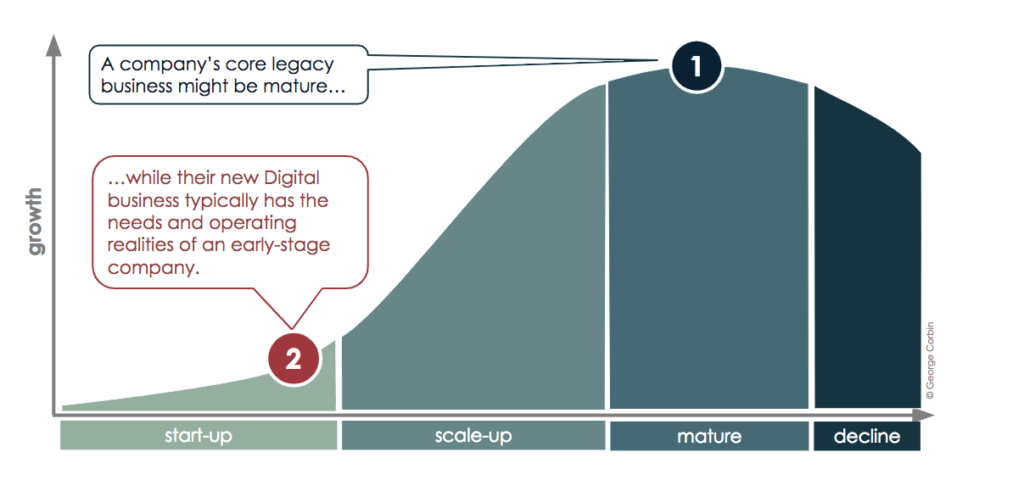I had been working in an industry that was being roiled by digital disruption. From the rapid rise of powerful online intermediaries and consumer platforms, to the massive consumer shift to online purchase behavior, to the plummeting costs of technology that had allowed insurgent startups to bypass entry barriers that incumbents had spent decades and billions of dollars erecting.
Our company had been responding: we were innovating and investing in new digital channels, growing sales by over $1 billion a year. That year’s hard-won investments were going to boost this even more. Then I got the voicemail: “Division X is struggling to meet their margin goals. They need everyone to cut costs. We need you to cut yours by 10%.”
In short, we needed to pare back the fastest growing part of our business to subsidize one that was mature and perennially lagging. With that voicemail, I realized that the biggest threat to our company’s future came from where I least expected: us.
The biggest “digital” threat facing successful incumbents? Themselves.
This is a common quandary faced by all incumbent companies today: run today’s core business, while simultaneously preparing for its disruption. These companies find themselves having to operate in two very different worlds… and those worlds are colliding.
Here’s why.
In general, today’s industry incumbents have arrived at their successful perches along the classic maturity S-curve (Figure 1). Over the course of years or decades, each has evolved from a promising start-up to a mature player, perhaps even the #1 player in their industry.

Of course, the requirements of a mature global powerhouse with far-flung operations, thousands of employees, and complex business risks are very different from those of a small, lean start-up. So throughout this growth journey, each company builds processes, systems, and controls to better equip it to scale, protect, and to perpetuate the business factors that make it successful. These include how it sets strategy and goals, serves customers, delivers products, allocates capital and budgets, manages risk, and develops talent.
But now enter a major disruptive hurricane like digital.
What happens to your sales force goals and incentives if your conventional retail channel is now being eroded by huge digital aggregators? What if your most profitable consumers are shifting their buying behavior to technologies that your infrastructure can’t handle? What if your new product development process takes years to launch new products, while insurgents are launching in weeks? What if your capital allocation process favors the “tried and familiar,” but can’t measure or fund the new and disruptive?
Certainly, leaders today recognize that new technology, new competitors, and new channels are causing disruption in their industry. Less appreciated, however, is not the causes of that disruption, but why is it so difficult for the company to respond? That is, what makes it so hard to operate simultaneously in the world it knows, and the new world that it doesn’t?
“It’s the operating model, stupid”
The greatest risk facing an incumbent company in a disrupted industry is generally not its inability to see the threat… but its inability to act. And that inability is usually due to the constraints of its legacy operating model.
The real heart of the challenge for most incumbent companies undergoing digital disruption is this: their current operating models are not fit-for-purpose for the new disruptive reality.
Figure 2 shows the hallmarks of companies straddling these two operating realities. This is where their internal worlds collide.

Also, to be clear: this is not an either/or choice between new vs. current operating models — the choice is “and.” We cannot kill the current operating model, because it remains critical to run 60-90% of today’s business.
So a company must keep doing what works for running today’s business (“don’t mess with success”)… but it also needs to prepare for tomorrow’s business (“don’t let today’s success drive you off tomorrow’s cliff”). Incumbents must adapt today’s operating model to accommodate digital disruption and ensure the current model does not hinder their ability to succeed in the digital environment.
Leaders must ascertain whether their current operating model is fit for purpose to handle digital disruption. Just as the levers shown in Figure 2 have been critical to the company’s success in its legacy world, they are just as critical in the new digital environment — but the tactics are different.
Hacking the operating model
So what can the “transformer” do to get traction for their transformation agenda “when worlds collide”? Strategies and tactics to tackle this would be the subject of a longer post, but here’s just a small sample of operating model causes and the “hacks” I’ve found to be effective:
Make the operating model an explicit part of your transformation gameplan
It is perilously hard for a company to escape the gravitational pull of its legacy business model. That business model was constructed over the years to keep the company safe and profitable. But a system built to help you run on land may not serve you well if you now need to fly.
Which brings me back to that voicemail.
It wasn’t just a message, it was a wake-up call. It underscored where our real challenge was: our powerful, fine-tuned operating model was superb for running our legacy business… but it was not designed to handle multi-lateral disruptions and a rapidly growing digital business. We redirected our focus to modifying nearly a dozen components of our company’s operating model, which ultimately led to innovation breakthroughs that unlocked investment and massive revenue growth.
For leaders of incumbent companies, disruption is not an event, it is a permanent operating reality. Today’s wave of disruption will be followed by another. These leaders must therefore build new muscle and versatility into their operating model to succeed in both worlds simultaneously.
